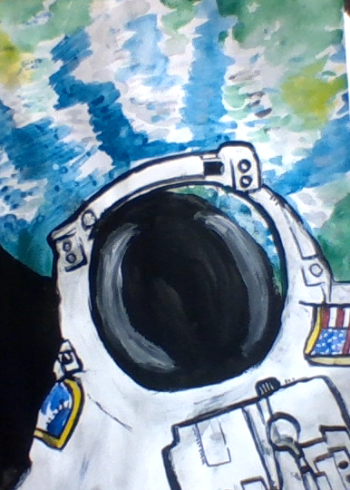Draw a character in outer space
Draw a space character floating among planets and stars using pencils and colors, design a spaceship, and write a short backstory.


Step-by-step guide to draw a character in outer space
Step 1
Place your paper on a flat surface so you have plenty of room to draw.
Step 2
Put your pencil eraser and sharpener within easy reach so you can work without interruption.
Step 3
Lightly sketch a circle for the head and a rounded shape for the body to plan your space character.
Step 4
Draw curved arms and legs that flow away from the body to show the character floating.
Step 5
Add a helmet and simple spacesuit details like seams gloves and a chest badge.
Step 6
Sketch a spaceship nearby using basic shapes like a cone for the nose and ovals for the windows.
Step 7
Draw several planets as circles of different sizes and place stars around the scene.
Step 8
Add details to each planet such as rings craters or stripes to make them unique.
Step 9
Go over your favorite pencil lines with a slightly darker pencil to make the final shapes stand out.
Step 10
Erase any light construction lines gently so your drawing looks clean.
Step 11
Color your space character using your coloring materials to bring them to life.
Step 12
Color the spaceship and each planet using different colors to create a vibrant space scene.
Step 13
Add simple shading or highlights with a darker or lighter color to give depth to your drawing.
Step 14
Write a short backstory of two to four sentences about your character who floats among the planets.
Step 15
Share your finished space character drawing and backstory on DIY.org
Final steps
You're almost there! Complete all the steps, bring your creation to life, post it, and conquer the challenge!


Help!?
What can I use if I don’t have a pencil eraser or sharpener as the instructions ask to put within reach?
If you don't have a pencil eraser or sharpener, keep a clean white vinyl eraser substitute or a folded piece of soft cloth for smudges and sharpen pencils carefully with fine sandpaper or an emery board so you can still follow the step 'Put your pencil eraser and sharpener within easy reach.'
My character's arms and legs look stiff when I try to make them float—how do I fix that?
To fix stiff limbs, follow the 'Draw curved arms and legs that flow away from the body' step by sketching very light guide curves and rotating the paper for looser strokes, then go over only your favorite pencil lines as the instructions suggest to keep the motion natural.
How can I change the activity for different ages, from toddlers to older kids?
For toddlers simplify to big circles for the head/body and basic coloring while skipping shading and the 'Write a short backstory of two to four sentences' step, and for older kids add detailed seams, planet textures, shading, and a longer backstory to expand the scene.
What are some ways to enhance or personalize my space character drawing beyond the basic instructions?
Enhance the drawing by adding aluminum foil or metallic pens for a shiny helmet, using a watercolor wash for a nebula background, and experimenting with layered colors when you 'Color the spaceship and each planet' and 'Add simple shading or highlights' to make the scene unique.
Watch videos on how to draw a character in outer space
Drawing and Coloring an Astronaut in Space 👨🚀🚀🌎⭐🌈 Drawings for Kids
Facts about space-themed drawing and storytelling
✒️ NASA crews often use special pressurized pens (like the Fisher Space Pen) that can write in zero gravity and extreme temperatures.
🎨 Concept artists and character designers start with quick sketches to invent spaceships, characters, and whole backstories.
🪐 Our Solar System has eight planets, from tiny Mercury to giant Jupiter.
🚀 Voyager 1, launched in 1977, is the farthest human-made object and has entered interstellar space.
🧑🚀 Astronauts on the International Space Station float because they're in microgravity — there’s no true "up" or "down" in orbit.
How do I draw a character floating in outer space and create a backstory?
What materials do I need to draw a space character, spaceship, and write a backstory?
What ages is this outer space drawing activity suitable for?
What are the benefits of drawing a space character and writing a backstory?


One subscription, many ways to play and learn.
Only $6.99 after trial. No credit card required



